Coherently Radiating Periodic Structures for Feeding Concentric Rings Array with Reduced Number of Phase Shifters
Abstract
1. Introduction
2. Phased Array Model
2.1. Concentric Rings Array
2.2. CORPS Networks
2.3. Proposed Model for Phased Antenna Arrays
3. Experimental Results
4. Conclusions
Author Contributions
Funding
Informed Consent Statement
Data Availability Statement
Conflicts of Interest
References
- Laue, H.E.A.; Plessis, W.P.d. Numerical optimization of compressive array feed networks. IEEE Trans. Antennas Propag. 2018, 66, 3432–3440. [Google Scholar] [CrossRef]
- Blake, J.; Nygren, E.; Shennum, G. Beamforming Networks for Spacecraft Antennas; International Symposium Antennas and Propagation Society: Boston, MA, USA, 1984. [Google Scholar]
- Bhattacharyya, A.K. Phased Array Antennas: Floquet Analysis, Synthesis, BFNs, and Active Array Systems; John Wiley & Sons: Hoboken, NJ, USA, 2006. [Google Scholar]
- Bevelacqua, P.J.; Balanis, C.A. Minimum sidelobe levels for linear arrays. IEEE Trans. Antennas Propag. 2007, 55, 3442–3449. [Google Scholar] [CrossRef]
- Haupt, R.L. Optimized weighting of uniform subarrays of unequal sizes. IEEE Trans. Antennas Propag. 2007, 55, 1207–1210. [Google Scholar] [CrossRef]
- Avser, B.; Frazita, R.F.; Rebeiz, G.M. Interwoven feeding networks with aperture sinc-distribution for limited-scan phased arrays and reduced number of phase shifters. IEEE Trans. Antennas Propag. 2018, 66, 2401–2413. [Google Scholar] [CrossRef]
- Juarez, E.; Panduro, M.A.; Reyna, A.; Covarrubias, D.H.; Mendez, A.; Murillo, E. Design of concentric ring antenna arrays based on subarrays to simplify the feeding system. Symmetry 2020, 12, 970. [Google Scholar] [CrossRef]
- Laue, H.E.A.; Plessis, W.P.d. Design and Analysis of a Proof-of-Concept Checkered-Network Compressive Array. IEEE Trans. Antennas Propag. 2022, 70, 7546–7555. [Google Scholar] [CrossRef]
- Singh, S. Minimal Redundancy Linear Array and Uniform Linear Arrays Beamforming Applications in 5G Smart Devices. Emerg. Sci. J. 2021, 4, 70–84. [Google Scholar] [CrossRef]
- Payami, S.; Ghoraishi, M.; Dianati, M.; Sellathurai, M. Hybrid Beamforming with a Reduced Number of Phase Shifters for Massive MIMO Systems. IEEE Trans. Veh. Technol. 2018, 67, 4843–4851. [Google Scholar] [CrossRef]
- Yin, L.; Yang, P.; Gan, Y.; Yang, F.; Yang, S.; Nie, Z. A Low Cost, Low in-Band RCS Microstrip Phased-Array Antenna with Integrated 2-bit Phase Shifter. IEEE Trans. Antennas Propag. 2021, 69, 4517–4526. [Google Scholar] [CrossRef]
- Dong, R.; Shi, B.; Zhang, X.; Shu, F.; Wang, J. Performance Analysis of Massive Hybrid Directional Modulation with Mixed Phase Shifters. IEEE Trans. Veh. Technol. 2022, 71, 5604–5608. [Google Scholar] [CrossRef]
- Betancourt, D.; del Rio, C. Designing feeding networks with corps: Coherently radiating periodic structures. Microw. Opt. Technol. Lett. 2006, 48, 1599–1602. [Google Scholar] [CrossRef]
- Garcia, R.; Betancourt, D.; Ibañez, A. Coherently radiating periodic structures (CORPS): A step towards high resolution imaging systems. In Proceedings of the 2005 IEEE Antennas and Propagation Society International Symposium, Washington, DC, USA, 3–8 July 2005; Volume 4B, pp. 347–350. [Google Scholar]
- Ferrando, N.; Fonseca, N.J.G. Investigations on the efficiency of array fed coherently radiating periodic structure beam forming networks. IEEE Trans. Antennas Propag. 2011, 59, 493–502. [Google Scholar] [CrossRef]
- Arce, A.; Cardenas-Juarez, M.; Pineda-Rico, U.; Covarrubias, D.H.; Stevens-Navarro, E. A multiple beamforming network for unequally spaced linear array based on CORPS. Int. J. Antennas Propag. 2015, 2015, 757989. [Google Scholar] [CrossRef]
- Panduro, M.A.; del Rio-Bocio, C. Simplifying the feeding network for multi-beam circular antenna arrays by using CORPS. Prog. Electromagn. Res. Lett. 2011, 21, 119–128. [Google Scholar] [CrossRef][Green Version]
- Arce, A.; Panduro, M.A.; Covarrubias, D.H. An approach for simplifying a multiple beam-forming network for concentric ring arrays using CORPS. J. Electromagn. Waves Appl. 2014, 28, 430–441. [Google Scholar] [CrossRef]
- Betancourt, D.; del Rio-Bocio, C. A novel methodology to feed phased array antennas. IEEE Trans. Antennas Propag. 2007, 55, 2489–2494. [Google Scholar] [CrossRef]
- Juarez, E.; Panduro, M.A.; Covarrubias, D.H.; Reyna, A. Coherently radiating periodic structures to reduce the number of phase shifters in a 2-D phased array. Sensors 2021, 21, 6592. [Google Scholar] [CrossRef]
- Arce, A.; Stevens-Navarro, E.; Cardenas-Juarez, M.; Pineda-Rico, U.; Simon, J.; Panduro, M.A. Design and Optimization of a Coherent Beamforming Network for an Aperiodic Concentric Ring Array. Int. J. Antennas Propag. 2019, 2019, 4601718. [Google Scholar] [CrossRef]
- Juarez, E.; Panduro, M.A.; Covarrubias, D.H.; Reyna, A.; Sanchez, B.J. An innovative way of using CORPS for phased arrays with reduced number of phase shifters. IEEE Trans. Antennas Propag. 2022, 70, 307–316. [Google Scholar] [CrossRef]
- Price, K.V.; Storn, R.M.; Lampinen, J.A. Differential Evolution: A Practical Approach to Global Optimization; Springer: Berlin/Heidelberg, Germany, 2005. [Google Scholar]
- Stearns, C.O.; Stewart, A.C. An investigation of concentric ring antennas with low sidelobes. IEEE Trans. Antennas Propag. 1965, 18, 856–863. [Google Scholar] [CrossRef]
- Balanis, C.A. Antenna Theory: Analysis and Design, 2nd ed.; Wiley: New York, NY, USA, 1997. [Google Scholar]
- Ooi, B.L.; Palei, W.; Leong, M.S. Broad-banding technique for in-phase hybrid ring equal power divider. IEEE Trans. Microw. Theory Technol. 2002, 50, 1790–1794. [Google Scholar]
- Parad, L.I.; Moynihan, R.L. Split-tee power divider. IEEE Trans. Microw. Theory Technol. 1965, 13, 91–95. [Google Scholar] [CrossRef]
- Hamdi, B.; Liman, S.; Aguili, T. Uniform and Concentric Circular Antenna Arrays Synthesis for Smart Antenna Systems Using Artificial Neural Network Algorithm. Prog. Electromagn. Res. B 2016, 67, 91–105. [Google Scholar] [CrossRef]
- Guo, Q.; Chen, C.; Jiang, Y. An Effective Approach for the Synthesis of Uniform Amplitude Concentric Ring Arrays. IEEE Antennas Wirel. Propag. Lett. 2017, 16, 2558–2561. [Google Scholar] [CrossRef]
- Das, A.; Mandal, D.; Ghosal, S.P.; Kar, R. Concentric circular antenna array synthesis for side lobe suppression using moth flame optimization. AEU Int. J. Electron. Commun. 2018, 86, 177–184. [Google Scholar] [CrossRef]
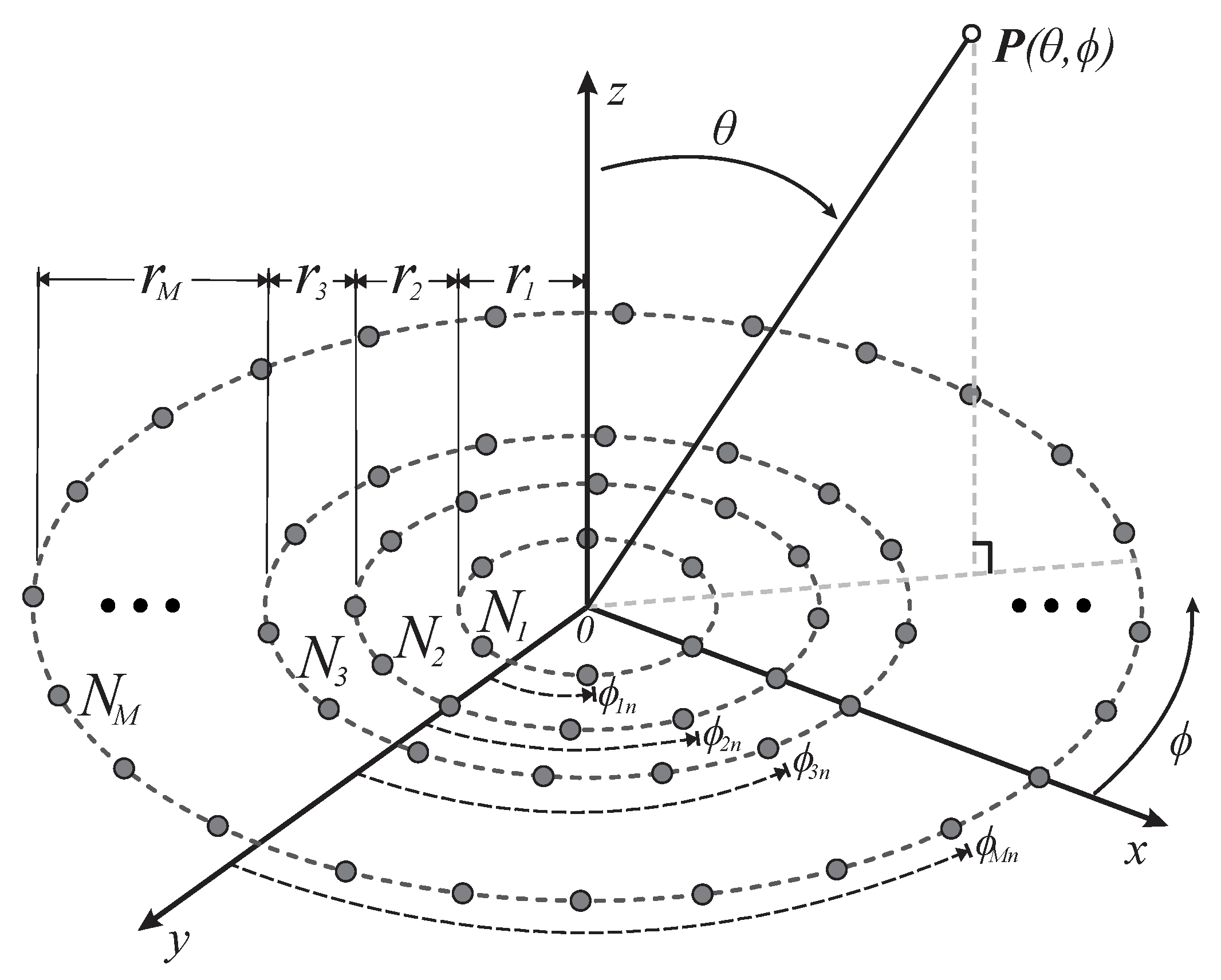
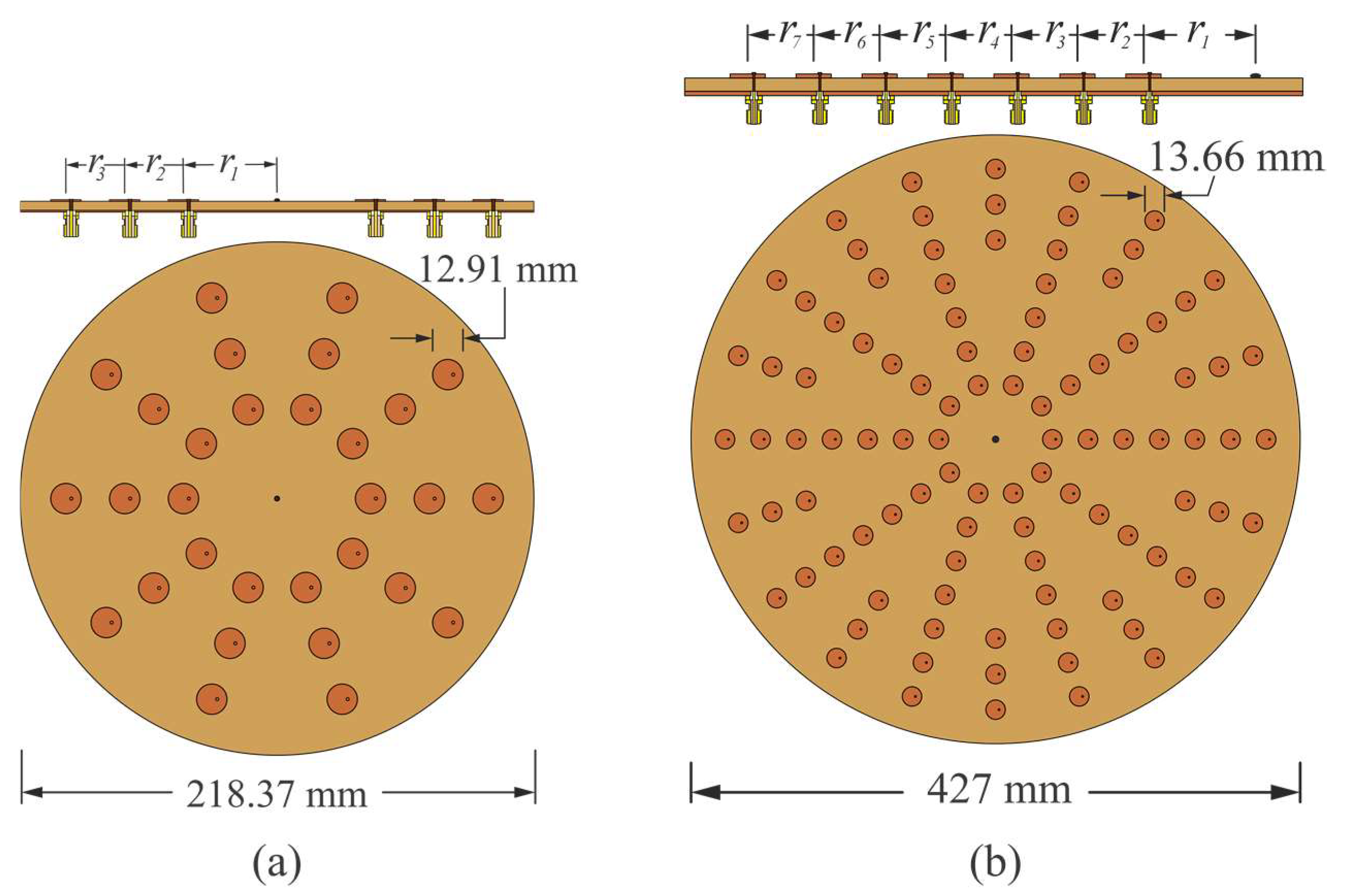

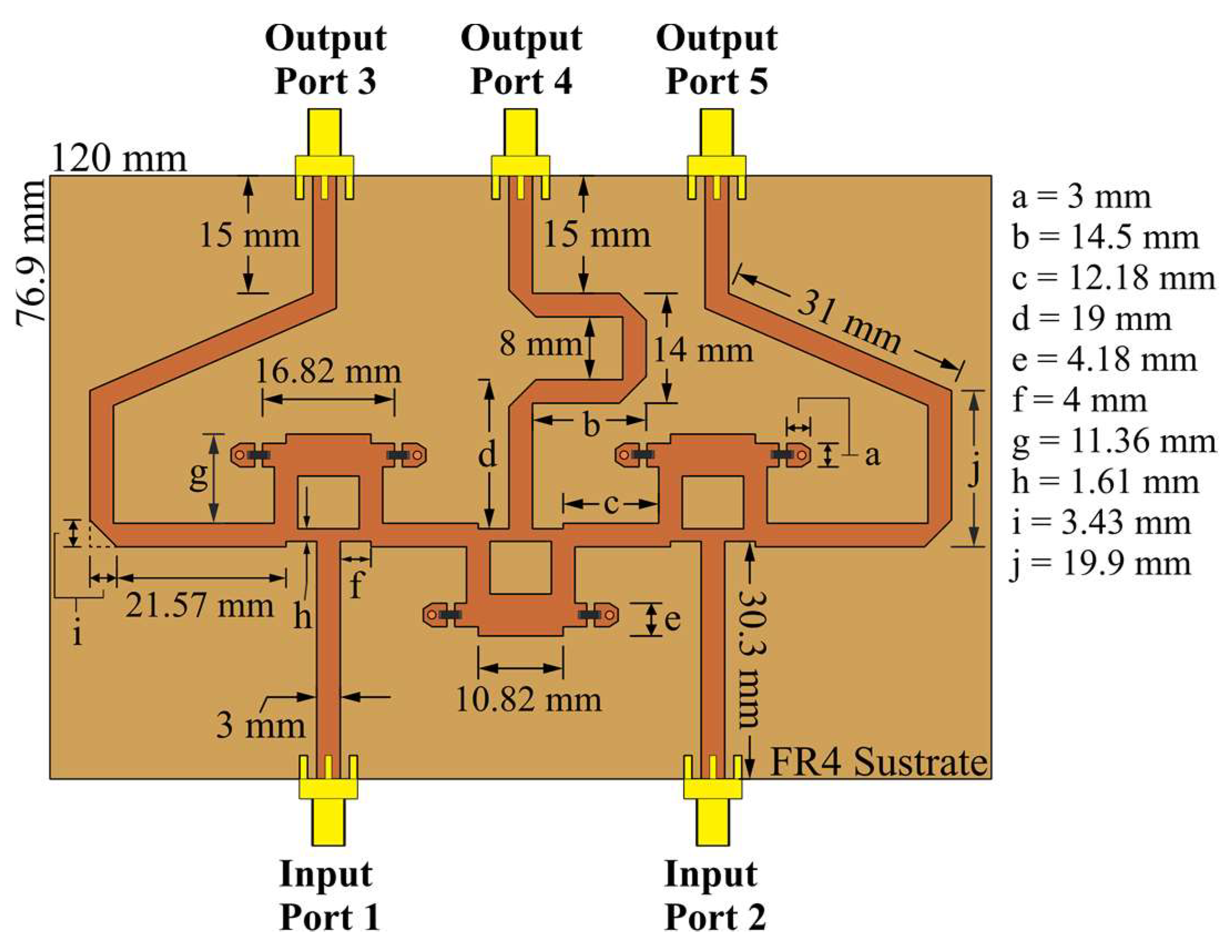
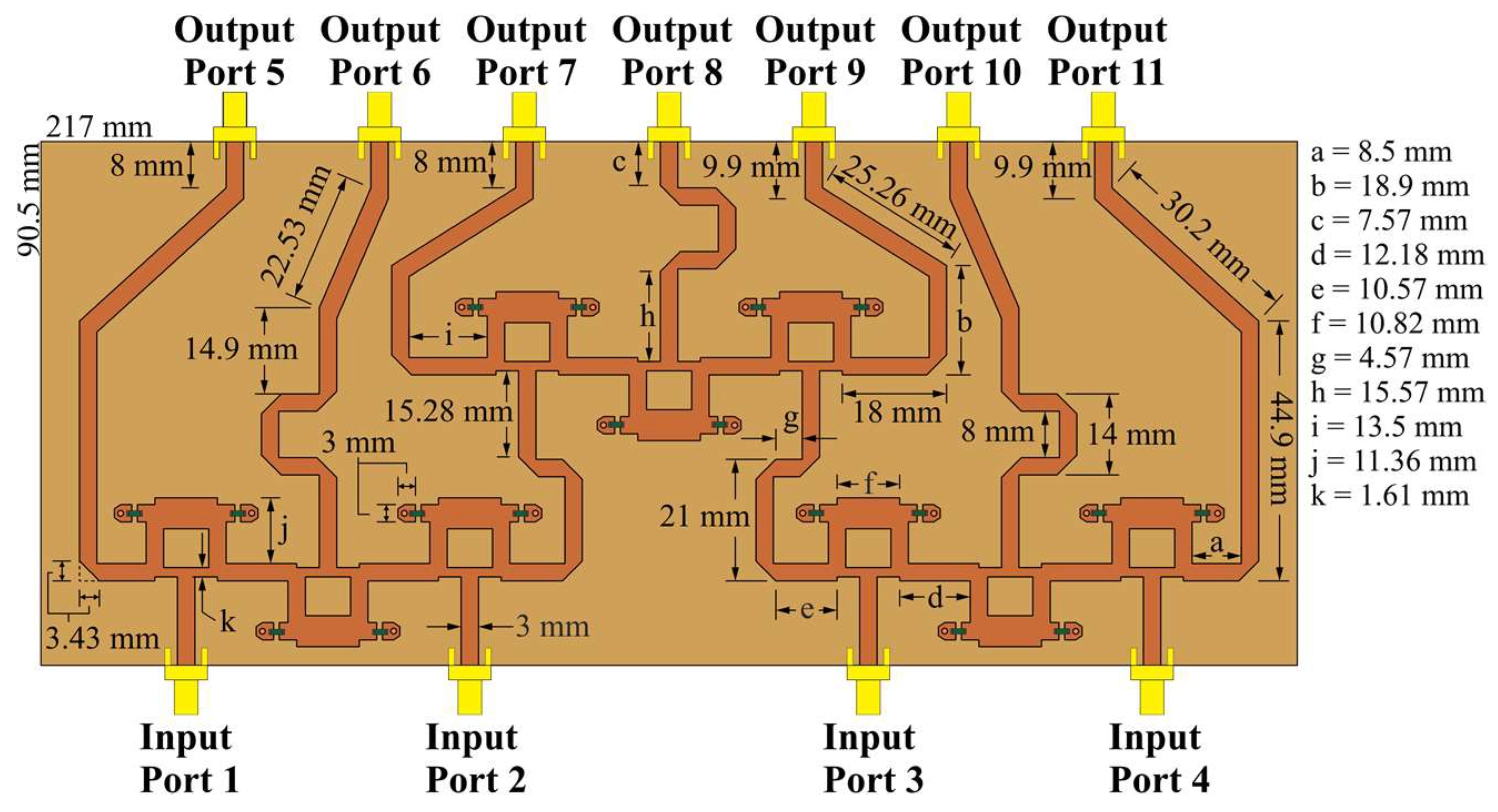



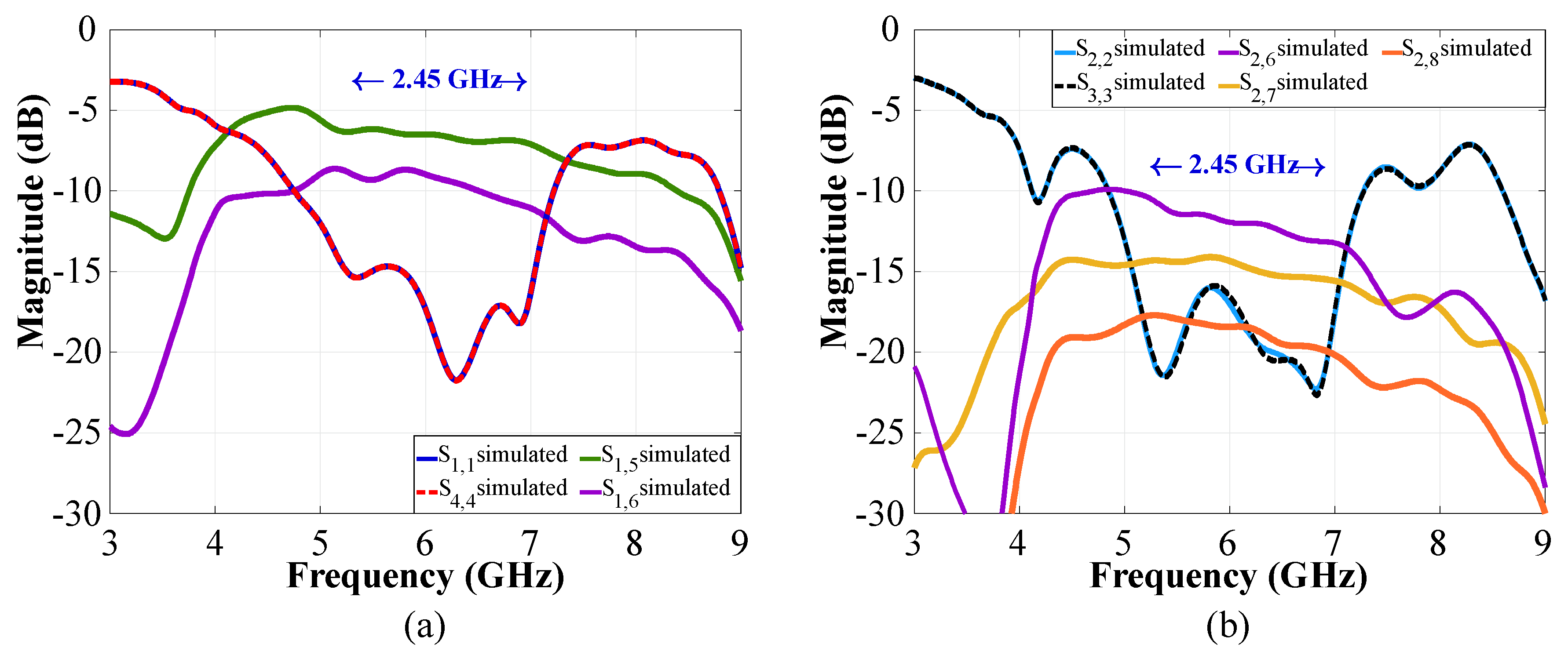

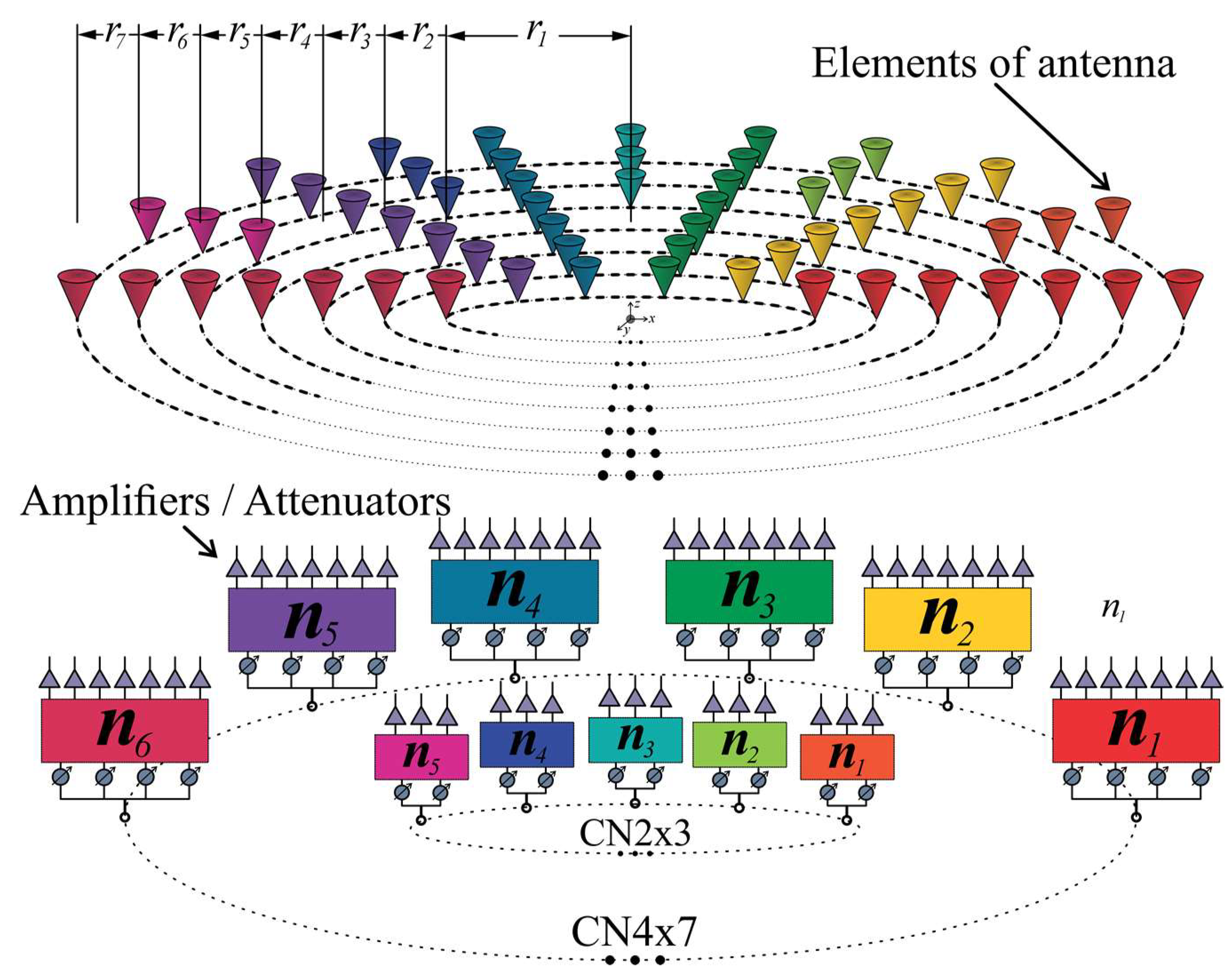

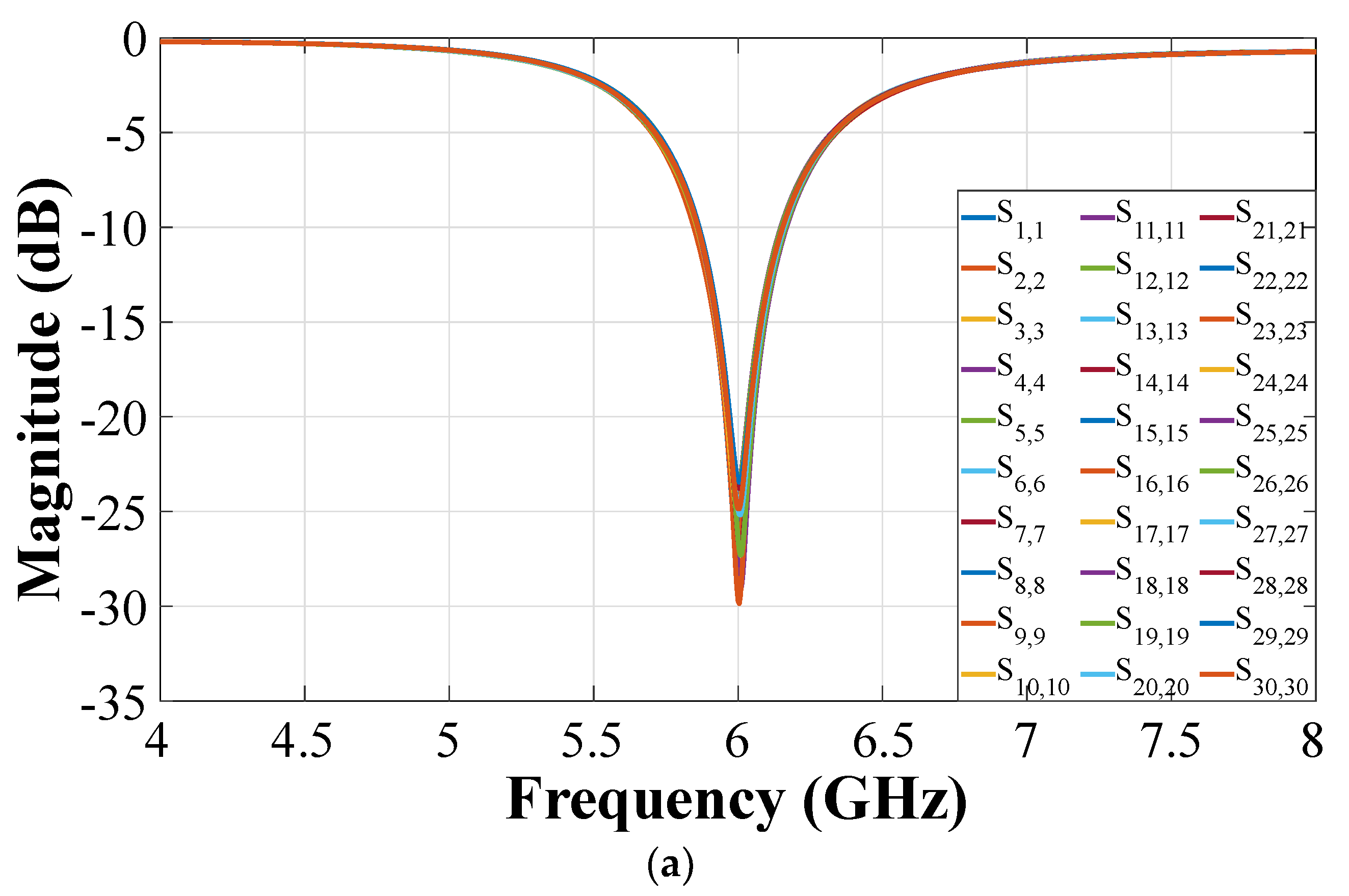
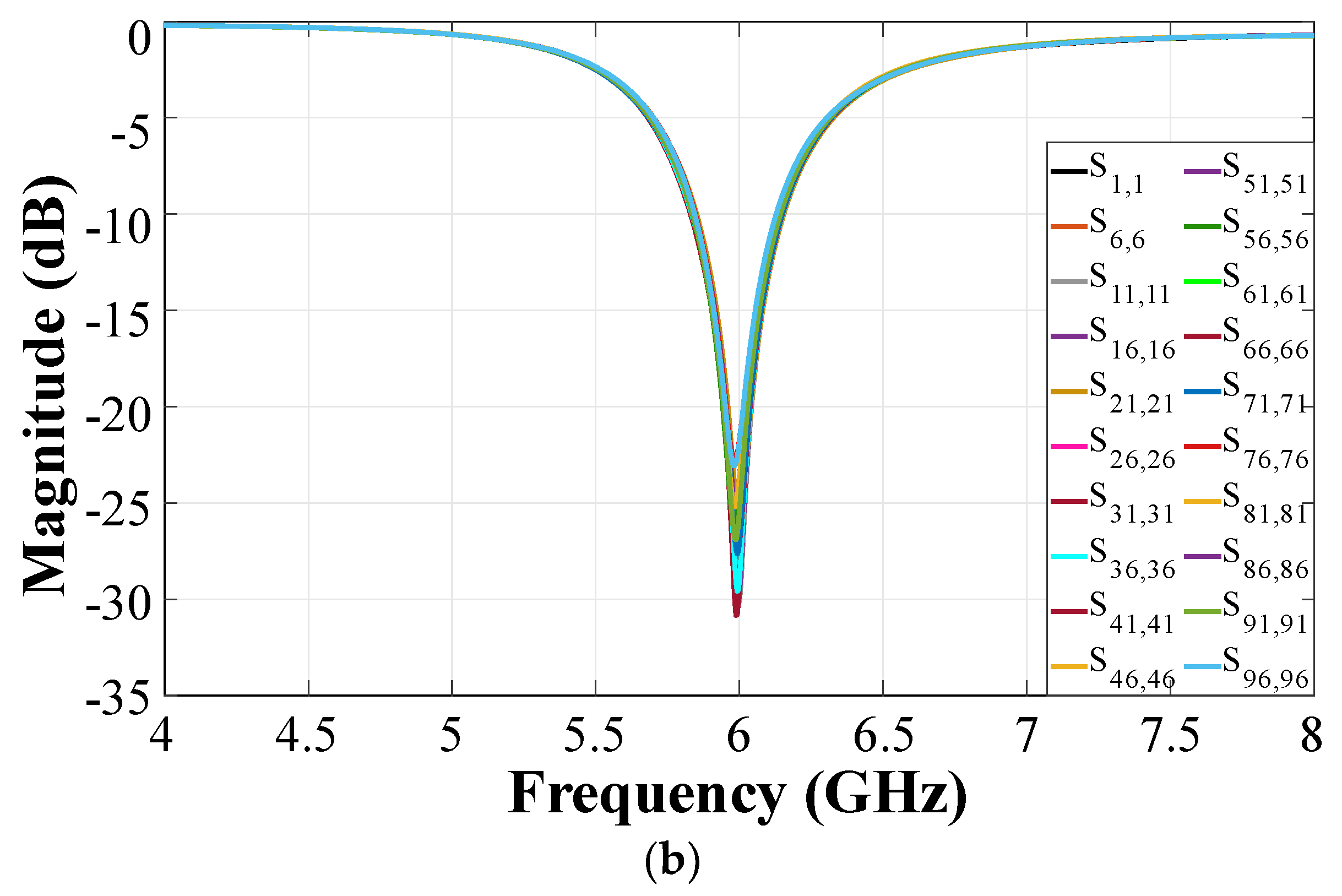
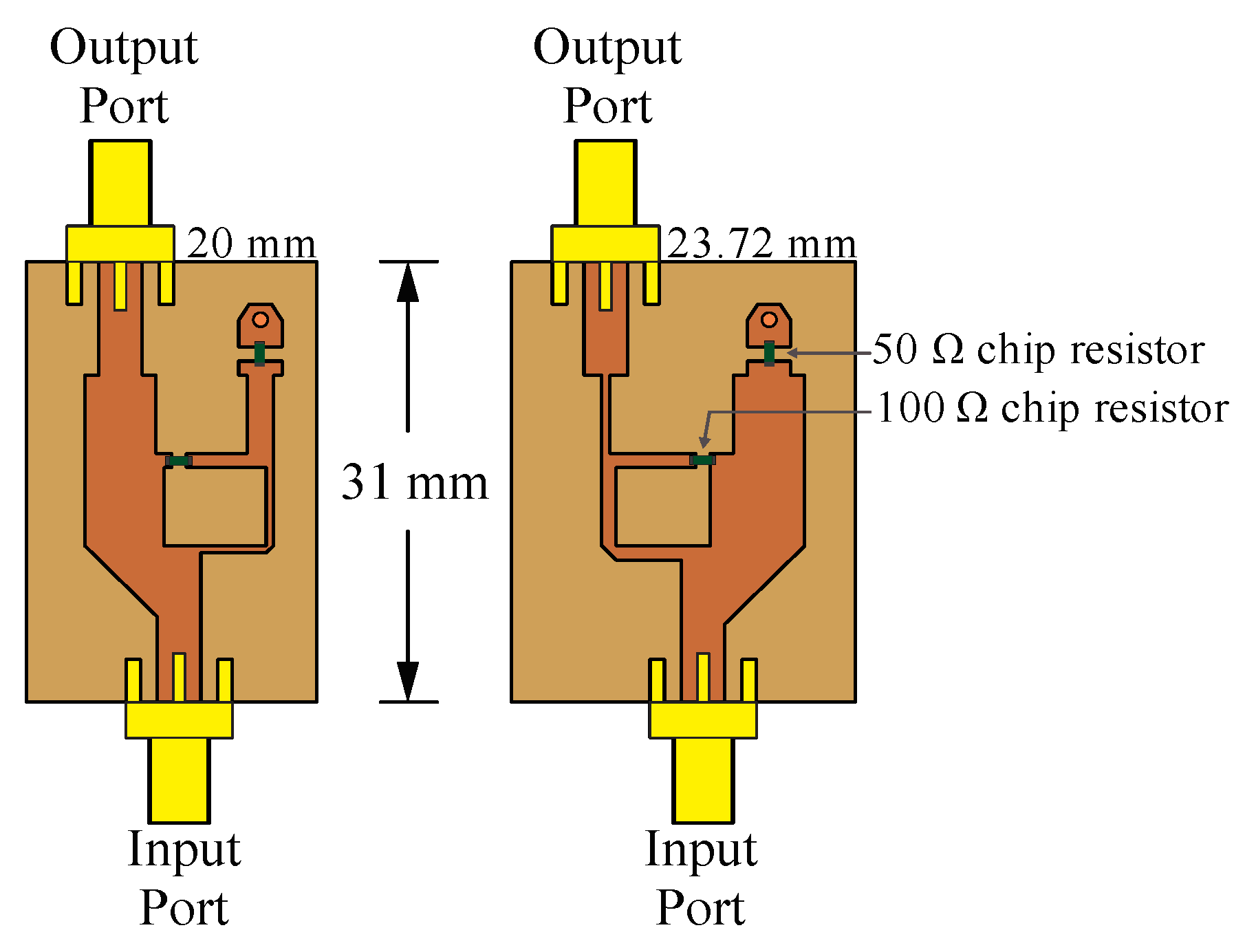
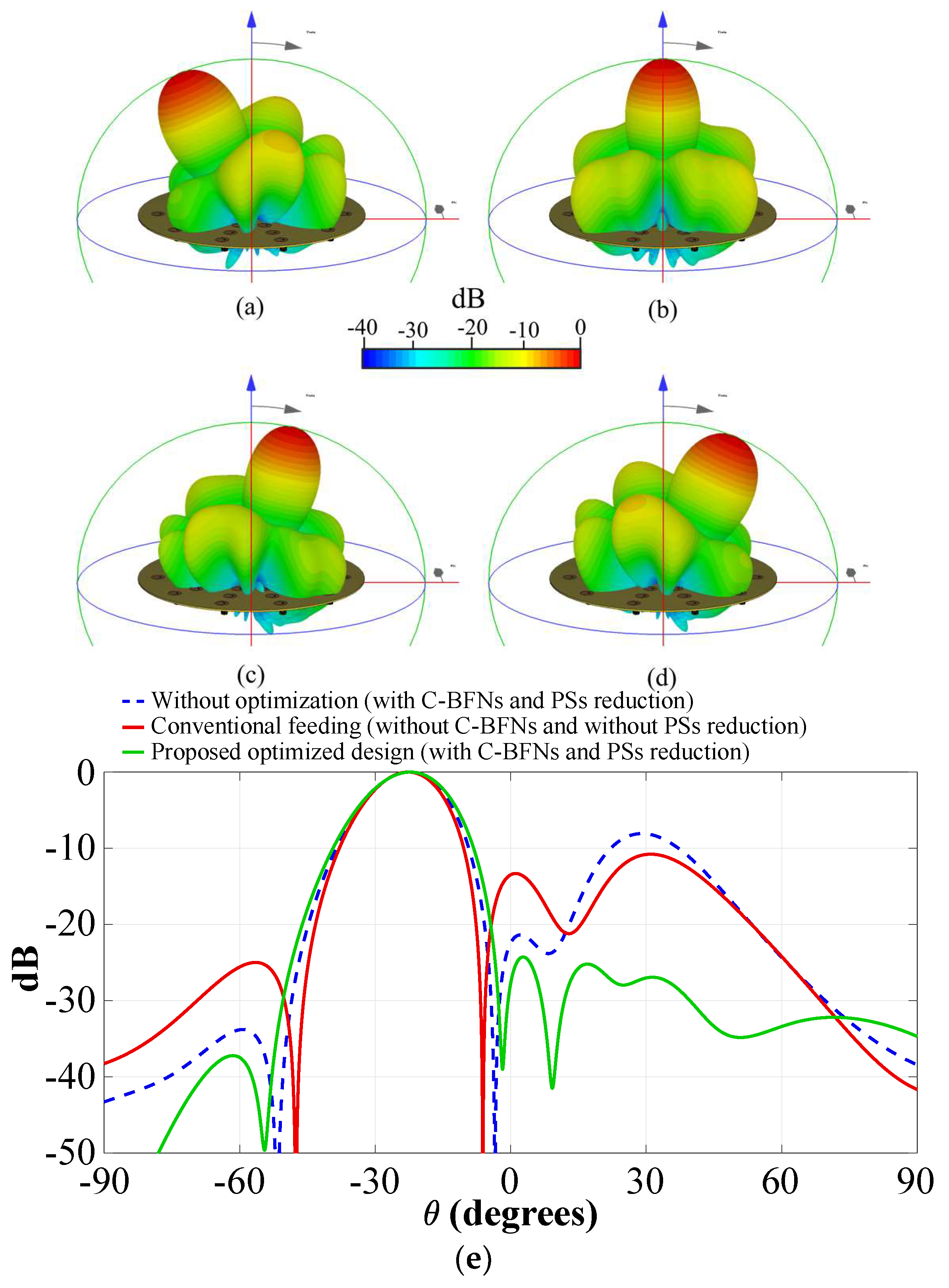
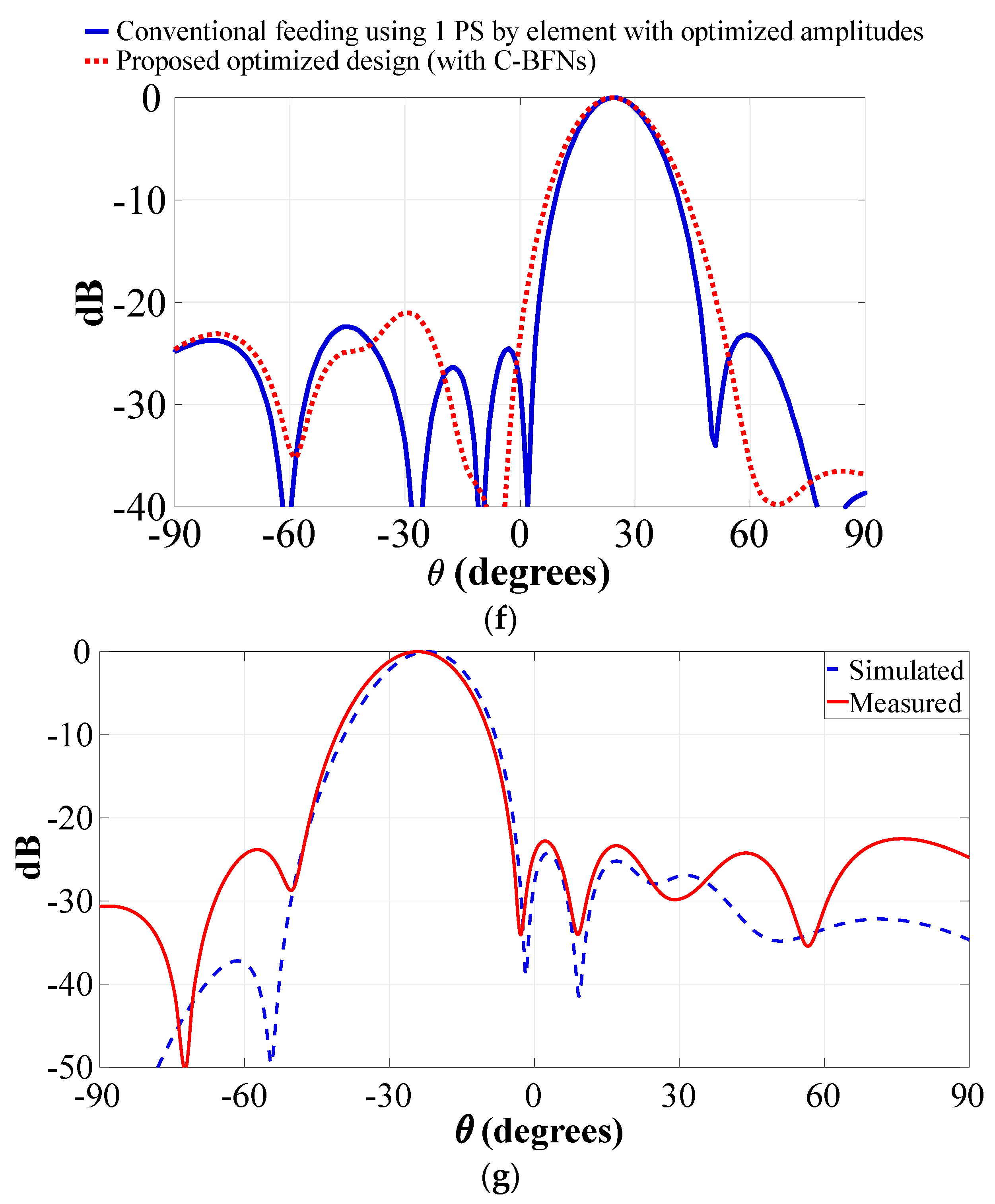
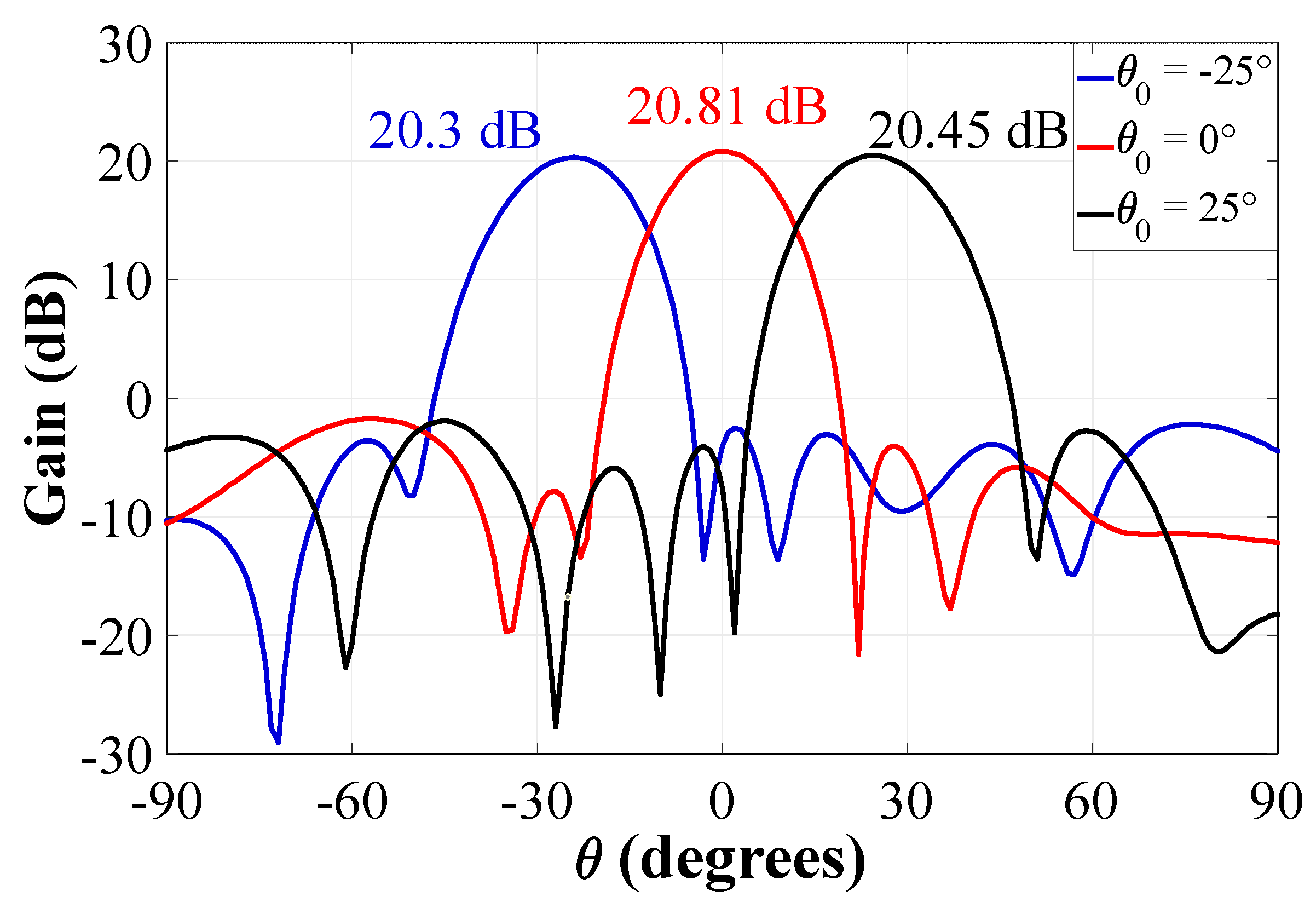

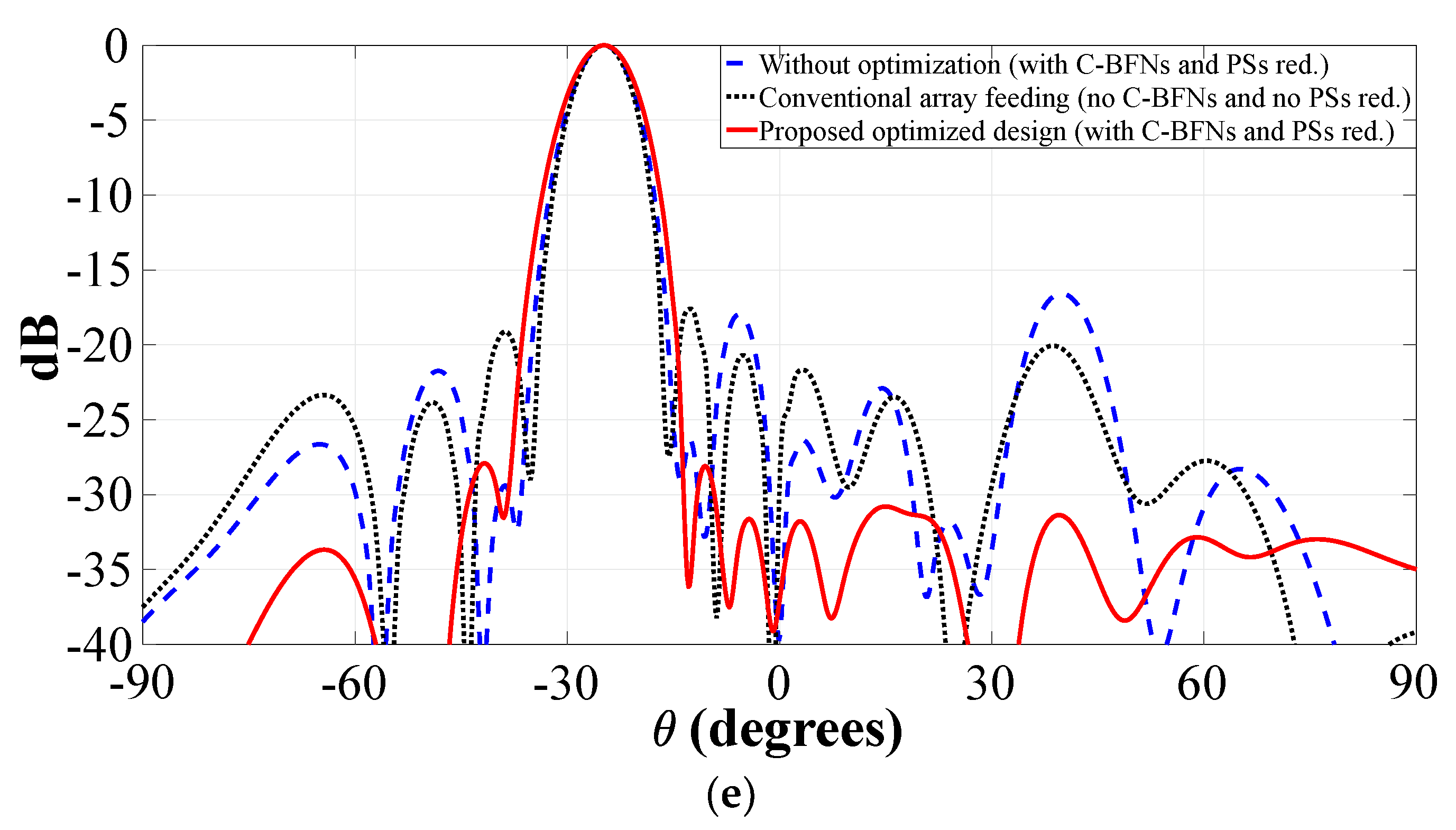
| CN2×3 No. | Element of Antenna | Phase Value (Rad) |
|---|---|---|
| 1 | 1, 11, 21 | −2.11, −3.44, −4.77 |
| 2; 10 | 2, 12, 22; 10, 20, 30 | −1.71, −2.78, −3.86 |
| 3; 9 | 3, 13, 23; 9, 19, 29 | −0.65, −1.1, −1.47 |
| 4; 8 | 4, 14, 24; 8, 18, 28 | 0.65, 1.1, 1.47 |
| 5; 7 | 5, 15, 25; 7, 17, 27 | 1.71, 2.78, 3.86 |
| 6 | 6, 16, 26 | 2.11, 3.44, 4.77 |
| Network No. | Antenna Element | Phase Value (Rad) |
|---|---|---|
| CN4×7 | ||
| 1 | 1, 11, 21, 31, 41, 61, 81 | −2.11, −3.44, −4.77, −6.1, −7.42, −8.75, −10.08 |
| 2; 10 | 2, 12, 22, 32, 43, 63, 83; 10, 20, 30, 40, 59, 79, 99 | −1.71, −2.78, −3.86, −4.93, −6, −7.1, −8.15 |
| 3; 9 | 3, 13, 23, 33, 45, 65, 85; 9, 19, 29, 39, 57, 77, 97 | −0.65, −1.06, −1.47, −1.88, −2.3, −2.7, 3.11 |
| 4; 8 | 4, 14, 24, 34, 47, 67, 87; 8, 18, 28, 38, 55, 75, 95 | 0.65, 1.1, 1.47, 1.88, 2.3, 2.7, 3.11 |
| 5; 7 | 5, 15, 25, 35, 49, 69, 89; 7, 17, 27, 37, 53, 73, 93 | 1.71, 2.78, 3.86, 4.93, 6, 7.1, 8.15 |
| 6 | 6, 16, 26, 36, 51, 71, 91 | 2.11, 3.44, 4.77, 6.1, 7.42, 8.75, 10.08 |
| CN2×3 | ||
| 1; 10 | 42, 62, 82; 60, 80, 100 | −7.06, −8.32, −9.58 |
| 2; 9 | 44, 64, 84; 58, 78, 98 | −4.36, −5.14, −6 |
| 3; 8 | 46, 66, 86; 56, 76, 96 | 0, 0, 0 |
| 4; 7 | 48, 68, 88; 54, 74, 94 | 4.36, 5.14, 6 |
| 5; 6 | 50, 70, 90; 52, 72, 92 | 7.06, 8.32, 9.58 |
| Model | Amplitudes |
|---|---|
| Configuration 1 | 1.9998 0.3621 1.8963 1.9419 0.2094 1.9184 0.1059 1.6764 1.8317 0.3447 0.9966 0.4440 0.2555 0.1302 0.6474 0.4949 0.4979 0.1406 0.3137 0.5950 0.8243 0.5703 0.1405 0.3697 0.2117 0.2139 0.5985 0.3781 0.3781 0.3781 |
| Configuration 2 | 0.4151 1.1743 1.2849 1.3340 0.5434 0.5843 1.3178 1.4168 1.1669 1.3718 1.3698 1.1058 1.4535 1.2601 0.7342 1.3838 1.3736 1.1524 1.3929 0.6461 0.8586 1.2891 1.2774 1.1981 1.4290 1.2180 1.4155 1.4239 1.1275 1.2777 0.6157 0.9340 0.4964 0.7554 0.8111 0.4849 0.7463 0.7183 0.9163 0.8420 0.5775 1.0298 0.8356 1.2533 0.5876 0.7050 0.6295 1.0512 0.8737 0.7361 0.5168 0.8362 0.7704 0.8781 0.7116 0.8127 0.5718 1.0242 0.5790 0.8141 0.6353 0.5105 0.5185 0.8109 1.0423 1.0958 0.4863 0.6007 0.5798 0.4462 0.4412 0.5110 0.6597 1.0407 0.8082 0.7466 0.7569 0.5486 0.4373 0.4019 0.5701 0.5093 0.5716 0.8326 1.2098 1.4269 1.1416 1.0053 0.4846 0.6187 0.6801 0.4758 0.5502 0.7493 0.7493 1.3071 1.3102 1.1493 0.4216 0.4216 |
| Element of Antenna | Attenuation Coefficient | Element of Antenna | Attenuation Coefficient |
|---|---|---|---|
| 1, 3, 4, 6, 8, 9 | −1.86 dB | 2, 10 | −8.13 dB |
| 5, 7 | −8.16 dB | 11 | −7.74 dB |
| 12, 20 | −8.39 dB | 13, 19 | −9.28 dB |
| 14, 18 | −9.34 dB | 15, 17 | −8.5 dB |
| 16 | −7.92 dB | 21 | −8.15 dB |
| 22, 30 | −8.16 dB | 23, 29 | −8.07 dB |
| 24, 28 | −7.99 dB | 25, 27 | −7.88 dB |
| 26 | −7.91 dB |
| Optimization | Number of Elements | Number of Phase Shifters | Reduction of Phase Shifters (%) | Scanning Range | Feeding Technique | Peak SLL (dB) | |
|---|---|---|---|---|---|---|---|
| Conv. case | No | 30 | 30 | 0% | (θ) | Uniform | −10 |
| This work: Conf. 1 | Yes | 30 | 20 | 33% | (θ) Scan loss = 0.5 dB | C-BFN | −24 (sim.), −22.5 (Measured) |
| This work: Conf. 2 | Yes | 100 | 60 | 40% | (θ) | C-BFN | −27.9 (Full-wave) |
| [18] | Yes | 90 | 60 | 33% | Not specified | C-BFN | −25 (Array factor) |
| [21] | Yes | 92 | 87 | 6% | Not specified | C-BFN | −23 (Array factor) |
| [28] | Yes | 49 | Not specif. | 0% | Not specified | Uniform | −34 (Array factor) |
| [29] | Yes | 201 142 134 | Not specif. | 0% | Not specified | Uniform | −29.03 −28 (Array factor) −29.07 |
| [30] | Yes | 18 30 | Not specif. | 0% | Not specified | Uniform | −36 (Array factor) −32.88 |
Publisher’s Note: MDPI stays neutral with regard to jurisdictional claims in published maps and institutional affiliations. |
© 2022 by the authors. Licensee MDPI, Basel, Switzerland. This article is an open access article distributed under the terms and conditions of the Creative Commons Attribution (CC BY) license (https://creativecommons.org/licenses/by/4.0/).
Share and Cite
Sanchez, B.; Panduro, M.A.; Covarrubias, D.H.; Reyna, A.; Juárez, E. Coherently Radiating Periodic Structures for Feeding Concentric Rings Array with Reduced Number of Phase Shifters. Sensors 2022, 22, 9528. https://doi.org/10.3390/s22239528
Sanchez B, Panduro MA, Covarrubias DH, Reyna A, Juárez E. Coherently Radiating Periodic Structures for Feeding Concentric Rings Array with Reduced Number of Phase Shifters. Sensors. 2022; 22(23):9528. https://doi.org/10.3390/s22239528
Chicago/Turabian StyleSanchez, Brian, Marco A. Panduro, David H. Covarrubias, Alberto Reyna, and Elizvan Juárez. 2022. "Coherently Radiating Periodic Structures for Feeding Concentric Rings Array with Reduced Number of Phase Shifters" Sensors 22, no. 23: 9528. https://doi.org/10.3390/s22239528
APA StyleSanchez, B., Panduro, M. A., Covarrubias, D. H., Reyna, A., & Juárez, E. (2022). Coherently Radiating Periodic Structures for Feeding Concentric Rings Array with Reduced Number of Phase Shifters. Sensors, 22(23), 9528. https://doi.org/10.3390/s22239528






